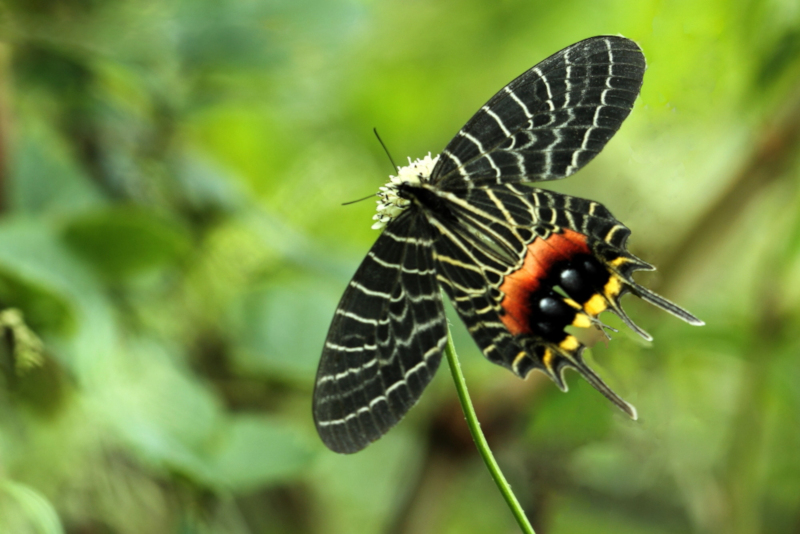Bhutan Glory Facts
- Most notably, Bhutan Glory serves as the much more pronounceable common name for the visually stunning Bhutanitis lidderdalii. By either name, this truly magnificent species of butterfly presently remains a subject of some debate among members of the scientific community. Further, this scientific debate has been ongoing for an extensive period.
- That’s because this somewhat heated debate goes back all the way to the time of its discovery by William Stephen Atkinson, in 1873. Beginning at that time, and continuing until today, numerous local entomologists consider the invertebrate to be rare. However, the IUCN presently lists the remarkable species as Least Concern, on its Red List of Threatened Species.
- However, the organization bases that placement on the nature of its moderately broad range of distribution. But most of that range consists of regions that are currently experiencing several conditions that greatly exacerbate its situation. In fact, one subspecies of the Lepidoptera in the region has already become extinct due to these conditions.
- Firstly, the awesome Bhuan Glory faces its most immediate threat from habitat loss. This holds true due to the ongoing deforestation of its native habitat. Secondly, its population also suffers losses due to ongoing illegal collecting for trade. But it also now faces the same looming threat that many other species around the world now face, that of climate change.
Related Articles
Bhutan Glory Physical Description
Firstly, the magnificent Bhutan Glory qualifies as a comparatively large variety of butterfly. Secondly, however, it does differ from the majority of related species in one way. That’s due to the fact that the fascinating invertebrate species displays no noticeable degree of the trait of sexual dimorphism.
This holds true partly due to the fact that mature individuals of both genders attain precisely the same average wingspan. That typical wingspan measures roughly 4.3 in (11 cm). Furthermore, both genders of the beautiful creature typically display exactly the same patterns of color and markings.
The upper side of the Bhutan Glory wings usually presents a dull black in color. This pattern provides camouflage in the shade of the trees. Also, very thin, cream-colored striations also remain visible on both sexes. These features cross the wings in a vertical manner, creating a striking appearance.
In addition, again differing from most other butterflies, the underside of the wings display patterns similar to the upper side. However, in a wonderful contrast, small colored patches appear at the base of both the upper and lower wings. Meanwhile, the body itself primarily displays black, with grayish-green markings.
- Kingdom: Animalia
- Phylum: Arthropoda
- Class: Insecta
- Order: Lepidoptera
- Family: Papilionidae
- Genus: Bhutanitis
- Species: B. lidderdalii
Bhutan Glory Distribution, Habitat, and Ecology
Quite unfortunately, the extent of the original habitat range of the Bhutan Glory remains unclear. However, its populations presently remain limited to only a few locations, including Bhutan. This serves as the source of the common name. Additional regions of habitation also include parts of Southeast Asia and Northeast India.
Yet, even within this range, the beautiful Lepidoptera has very specific habitat requirements. That’s because, within this area, individuals generally inhabit altitudes ranging between 5,000-9,000 ft (1,524-2,743 m). Further, for reasons still unknown, the butterfly usually prefers forests on mountain ridges to valleys.
This Bhutan Glory evolved specialized behavior patterns, advantageous for its environment. It typically moves slowly and erratically at treetop level. Coupled with its natural coloring, this often makes it difficult to see in the shadows. In this manner, individuals routinely travel from hilltop to hilltop.
But, its life cycle remained mystery to researchers until 2019. At that time, detailed observations occurred for the first time. After hatching, the larva of this marvelous insect goes through an astounding eight stages, as well as a pupal stage, prior to reaching adulthood. This takes about 188 days. Following this, the adult lives for an extremely long time for a butterfly, about 179 days.
Species Sharing Its Range
Check out our other articles on 7 Spectacular Herbaceous Plants of the World, Golden Armadillo Lizard, Devetashka Cave, Barreleye Fish, California Sea Lion, Blue Footed Booby

